On June 5, American Airlines is set to redefine the concept of luxury in air travel with the launch of its Flagship Suite business class, introduced on the innovative Boeing 787-9 Dreamliners. In a bold move to enhance passenger experiences, the airline is not merely upgrading seating arrangements; it’s creating an immersive environment tailored to meet the evolving expectations of travelers in the premium segment.
Innovative Features Go Beyond Comfort
Unlike traditional business class configurations, the new Flagship Suites ingeniously incorporate a sliding privacy door, providing a cocoon of tranquility amidst the hustle and bustle of air travel. But it doesn’t stop there. The unique chaise lounge seating option allows for greater versatility, catering to those who prefer lounging during long-haul flights while still providing a well-designed workspace for business travelers.
This hospitality extends to the thoughtful addition of wireless charging pads and more personalized storage spaces, factors which can elevate the overall experience considerably. In a world increasingly reliant on technology, these conveniences are not just perks—they’re essential. When flying, few things is more irritating than having to juggle tech accessories with limited space. American Airlines clearly understands this, aiming to create a sanctuary that feels thoughtfully curated.
Boosting Premium Economy: Size Matters
American Airlines is also making significant strides in its premium economy offerings. The new aircraft will feature premium economy seats that boast double the storage space compared to their predecessors. This change signals a commitment not only to comfort but also to passenger pragmatism. In a class where legroom is often prioritized, adding functional storage changes the game. Larger entertainment screens offer more than just a distraction; they signify the airline’s ambition to keep pace with industry trends, where customers seek not only comfort but also enriched in-flight content.
In an age where privacy in public settings is increasingly valued, the extension of arms from headrests for added seclusion is a keen addition. This design addresses a universal desire for a bit of personal space, allowing travelers to feel less exposed when dealing with long flights or engaging in serious tasks.
The Strategic Route Rollout
The first aircraft featuring these new offerings will enter service on the lucrative Chicago O’Hare to London Heathrow route, a strategic choice that signals American’s intention to capture the discerning traveler market. Subsequent routes—such as Philadelphia to Heathrow and Philadelphia to Zurich—are poised to capitalize on the demand for superior comfort. The timeline for introducing these remarkable aircraft indicates a long-term strategy to enhance American’s competitive edge as they anticipate receiving up to 30 Dreamliners by 2029.
Such foresight demonstrates a clear acknowledgment of the shifts in consumer preferences by airlines, with an increasing focus on experience over mere transport. As travel resumes in a post-pandemic world, this strategic pivot sets American Airlines apart, positioning them not just as an airlines but as an experience provider.
With these enhancements, American Airlines is not merely participating in the competition; they are aiming to set a new standard, making air travel not just a means to an end but a pleasure in itself.

